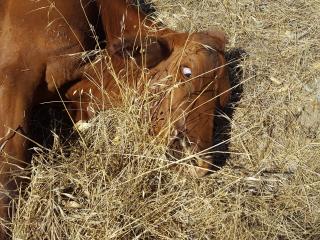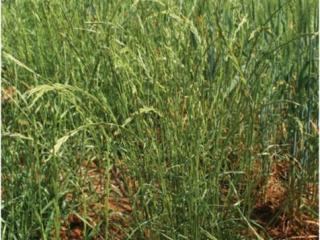| Calling a vet to investigate diseases protects markets |
|---|
| The WA Livestock Disease Outlook provides information about recent livestock disease cases in Western Australia and diseases likely to occur in the next month. Calling a vet to investigate diseases when they occur provides surveillance evidence to our markets that we are free of reportable and trade-sensitive diseases. |
Recent livestock disease cases in WA
Deaths in cattle fed vegetable scraps
- In a mob of 18, one-year-old cattle, seven died and six were affected with dyspnoea and abdominal breathing. The cattle appeared anaemic and were being fed a variety of vegetable scraps (including sweet potatoes), wheat stubble, hay and pellets.
- Histopathology showed a severe, diffuse, subacute interstitial pneumonia with emphysema. A diagnosis was made of toxic interstitial pneumonia likely due to ingestion of mouldy sweet potatoes.
- Sweet potatoes can be colonised by a fungus which causes production of the toxin 4-ipomeanol.
- Differential diagnoses: Fog fever, bacterial pneumonia, bovine respiratory disease complex, bovine anaemia due to Theileria orientalis group (BATOG) where anaemia is present.
- Waste vegetables may be a source of of animal matter as well as toxins. Animal matter-contaminated food constitutes restricted animal material and is illegal to feed to ruminants in Australia.
Respiratory signs and sudden death in cattle in the Midwest
- A total of 14 Droughtmaster cattle from a mob of 180 died suddenly within 7-10 days of being moved onto an oat stubble paddock with others showing respiratory and neurological signs.
- Deaths stopped when cattle were moved to another paddock.
- The cattle showed no further signs until cattle were fed hay cut from the oat stubble paddock. Several days later, 20 cattle died. Sheep fed the same hay were unaffected.
- Testing of the hay samples showed moderate and high risk of annual ryegrass toxicity (ARGT). A faecal test from one of the dead cattle was also positive for ARGT.
- Differential diagnoses: bovine spongiform encephalopathy (exotic) in animals showing neurological signs, thiamine deficiency, grass tetany. Discuss with your DPIRD vet subsidies available for testing where signs may be similar to exotic diseases such as transmissible spongiform encephalopathies.
- Paddock management strategies to reduce the risk of ARGT in livestock include hay testing prior to feeding out, managing grazing of the paddock to remove seed-heads before they become toxic, controlling the ryegrass or sowing a safe ryegrass variety. Read more on these control strategies.
In autumn, watch for these livestock diseases:
| Typical history and signs | Key samples |
|---|---|
Gastrointestinal (GIT) worms in cattle
| Ante-mortem:
Post-mortem:
|
Pregnancy toxaemia in ewes
| Ante-mortem:
Post-mortem:
|
Calf diarrhoea/scours
| Ante-mortem: 10mL faecal sample (chilled) from 5 affected animals if possible |
Note: Include base samples and any clinical or gross lesions in submissions. For sample submission advice, contact your DPIRD field vet or the duty pathologist on +61 (0)8 9368 3351.
Register now for the next livestock disease investigation workshop!
Want to hear some great speakers and brush up on your post-mortem skills? There are two highly recommended workshops for livestock disease investigation coming soon:
- Livestock disease investigation weekend workshop at Pagoda Resort, Como, on 23–24 June 2018 (Keynote speakers: Dr Tristan Jubb and Dr Kim Halpin, Australian Animal Health Laboratory)
- Practical post-mortem workshop with Dr Tristan Jubb at DPIRD, South Perth, on 25 June 2018 (limited places).
Participation is free to rural practitioners, including meals and accommodation during the workshop.
For details and to register, see the Documents link on this page or contact your local DPIRD vet or Dr Gill Scroxton +61 (0)8 9956 8505 or 0418 943 064, email gill.scroxton@dpird.wa.gov.au.
DPIRD is pleased to facilitate this event, supported by funding from the Agricultural competitiveness white paper through the Department of Agriculture and Water Resources.
Feedback and subscriptions
We welcome feedback. To provide comments on the monthly email newsletter, email waldo@dpird.wa.gov.au. To subscribe or to see previous issues, see our WA Livestock Disease Outlook archive page.


